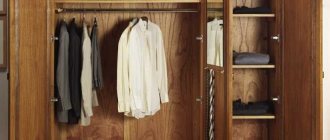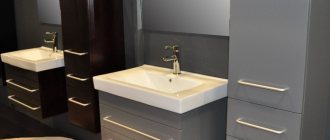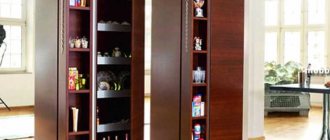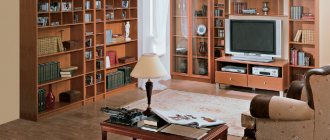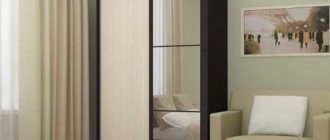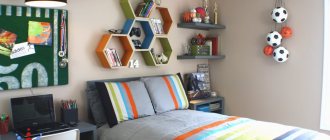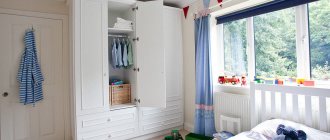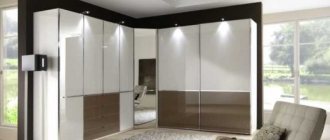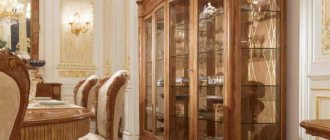What it is?
According to the definition of the Brief Encyclopedia of Housekeeping, a wardrobe or wardrobe is furniture for storing different types of clothing, including dresses, equipped with doors, drawers, mirrors, and hangers. Some people also call such a wardrobe a wardrobe or a wardrobe, but this is incorrect - there are no such words in the Russian language.
In the wardrobe you can store coats, suits, shirts, dresses, blouses, knitwear, underwear, hats, and accessories. A traditional wardrobe is a closet with two or three hinged doors, behind one of which there are drawers and shelves, and behind the other or two others there is a hanger.
The wardrobe appeared in England in the 18th century and it was called a wardrobe (from the French words “to store” and “dress”). It originated from a chest used for storing clothes.
In medieval castles, a wardrobe was a room specially allocated for storing clothes, with small closets along the walls. The wardrobe in the castle simultaneously served as a place for dressing and undressing, a hair salon, and a sewing workshop.
Articles on the topic (click to view)
- Blackout curtains for the bedroom
- Blackout curtains for the bedroom
- Photo of a bedroom with beautiful curtains with eyelets
- Photo of cornices and curtains in the bedroom interior
- Photo of a built-in, white wardrobe in the bedroom
- Photo of a closet above the bed in the bedroom
- Photo of a dressing table with a mirror in the bedroom
In the 19th century, the interior content of the wardrobe came closer to its modern form. In the linen closet, compartments for hanging clothes appeared, and a little later, the equipment of this piece of furniture was supplemented with a mirror and internal shelves.
At that time, wardrobes were most often made from mahogany, decorated with intricate carvings, and polished wood was used for decoration.
Today, a wardrobe is not so often used to store clothes in the house; preference is most often given to dressing rooms and wardrobes. But nevertheless, it is the classic version of the wardrobe that can give the interior a certain stylistic coloring.
A significant advantage of wardrobes is that if you want to change the space of the room, the wardrobe can be quickly moved to any place.
Wardrobe – time-tested furniture
A closet always and everywhere remains a permanent repository of your favorite things. More than one millennium in the history of the wardrobe. Its first appearance is celebrated in Great Britain. And although the country’s development was very slow, this piece of furniture firmly took its place of honor. Before the closet was invented, things were stored in chests and bulky chests of drawers.
But, with the advent of a tall, spacious, and most importantly, capacious wardrobe, the need for chests of drawers and chests disappeared. The wardrobe grew along with the wealth and size of the residences of noble families. Due to the fact that in castles and palaces there was a large amount of free space, the role of a wardrobe or wardrobes was assigned to separate rooms in which there were small cabinets and cupboards located along the walls. Such rooms were used for storing clothes and also as changing rooms. Very often, such rooms could be used to store expensive things, such as jewelry, securities, and fur. Another purpose of the dressing room was its use as a hairdressing room.
The transformation of the dressing room into a wardrobe proceeded rather slowly, and by the 17th century the wardrobe began to act as a separate piece of furniture, intended for storing exclusively clothes. By this time, in Great Britain, most of the trees had been cut down, and therefore wardrobes were imported from America. They were made roughly from solid oak, which is why they looked bulky.
But it should be noted that wardrobes began to be decorated with carved decorative facades. In the 18th century, wardrobes were made of walnut. They also remained heavy and massive. The wardrobe began to acquire modern forms due to changes in design already in the 19th century. They began to produce it with additional compartments where clothes could be hung. Mirrors have just begun to appear as an addition to the wardrobe, and the doors have been widened to such an extent that it has become possible to install horizontal shelves inside the wardrobe. The latest materials began to be used in its production; metal parts and steel tubes began to act as accessories. Mahogany was used in the production of wardrobes. Soon it was replaced by satin and some other exotic types of wood. Over time, this wood became more and more available. Wardrobes were already decorated with beautiful carved patterns, and many craftsmen often used polished wood in production.
Today's wardrobe has not lost its relevance. It is also popular and necessary in everyday life. The wardrobe remained the main item in bedrooms.
It is difficult today to find a room that does not have this piece of furniture. Every person's wardrobe should have an excellent appearance; it should not be dusty or wrinkled. This is exactly the function that a wardrobe performs, the purpose of which is to store any clothes and linen.
To install a wardrobe in small apartments, use a corner design. It is equipped with mezzanines, a number of drawers, and various niches. Today's closets are equipped with internal lighting, as well as all kinds of internal fixtures that can even be designed for shoes. All these changes bring some comfort and coziness into a person’s life. In the production of cabinets, it is necessary to take into account any consumer needs. Starting from the design of the cabinet - be it a standard shape or corner, to the number of doors in this cabinet - from a two-leaf cabinet to a four-leaf one. To satisfy the demand of each customer, we have to produce wardrobes of various types.
A wardrobe can act as a separate piece of furniture, or it can be part of a bedroom set. The most popular wardrobe model is the double-leaf wardrobe, made in an antique style. This cabinet model is usually complemented by a mezzanine. Behind one of these doors there are horizontal shelves that are designed for storing linen. Very often a large mirror is installed in a wardrobe. It can be located both inside the cabinet and outside. A mirror installed outside can also serve as its decoration. In another compartment of the closet there is a rod, which is intended for hanging things.
As soon as mass production was established in the 20th century with the introduction of new technologies, every person had the opportunity to have a wardrobe with thoughtful decor and fittings in their home.
It has become possible to create custom-sized wardrobes and built-in wardrobes using the latest achievements in furniture production.
Types and models
A wardrobe is cabinet furniture consisting of several sections designed to store clothes.
The wardrobe has blank side and back walls. The façade is equipped with doors. Depending on the number of doors, a wardrobe can be single-leaf, double-leaf, or three-leaf. There are also huge models with a large number of doors.
Wardrobe doors can be hinged, sliding or folding.
A single-door wardrobe is most often placed in small rooms, since it has modest dimensions. This piece of furniture only has a hinged opening. It is also called a travel bag or pencil case. A minimum set of clothes for every day is stored here. It is equipped with a small number of shelves and a hanging rod.
Standard two-door and three-door wardrobes allow you to store a much larger volume of clothes. The opening here can be either hinged or sliding.
Expert opinion
Smirnova Ekaterina Anatolevna
7 years of experience in interior design, professional architect
This piece of furniture has many compartments for different types of clothes. There is always a section with shelves and drawers, as well as compartments equipped with a rod that can run along or across the cabinet.
The transverse arrangement allows you to store a much larger volume of things on hangers. In modern models of wardrobes, the rods are equipped with a pantograph system, that is, they extend and retract, rise and fall.
Large wardrobes have shelves for storing hats, shoes, a mirror, holders for belts and ties.
Sometimes a standard wardrobe can be supplemented with a mezzanine - an independent furniture module that is placed on top of the wardrobe. As a rule, such a module is equipped with shelves for storing linen and bags.
The shape of wardrobes can be straight or angular. The straight model has a classic rectangular shape.
It is placed along the wall or between other pieces of furniture (for example, next to a chest of drawers or a bookcase). The corner model is intended only for installation in the corner of the room.
Suitable for both spacious and small rooms, as it saves space.
A very interesting solution is a double-sided wardrobe , which has an opening from both the front and the back. This design is used as a kind of partition for zoning space.
Wardrobe: types and characteristics - VCC Facade
As you know, any apartment requires various types of furniture - both to accommodate people and to store clothes and other items. Many devices are used as pieces of furniture for storing clothes, which include chests of drawers, cabinets, bedside tables, wardrobes, hanging drawers and shelves, but this article is devoted to the choice of cabinets.
First of all, you need to have information about the types of cabinets available. They are classified as free-standing, partially built-in, built-in, modular.
Wardrobes of the first type are characterized by the ability to move freely around the room. The components of such a cabinet are the top, bottom and side parts, doors. The advantage of free-standing cabinets is that they can be used to model the space of a room. For example, by installing such a cabinet in the middle of the room, you can divide it. Freestanding wardrobes are suitable for elegantly designed large apartments.
Partially built-in models are adjacent to the ceiling or wall, and these surfaces of the room partially play the role of cabinet elements. As a result, such cabinets do not have such extensive possibilities for moving around the room as models of the first type. Partially built-in wardrobes are based on the format of the room.
Built-in wardrobes lack some elements, for example, the top, back, sides or bottoms, which are then replaced by the ceiling, wall or floor surfaces of the room. In most cases, I use cabinets of this type to correct the layout, occupy an empty niche, or organize as compact a place as possible for storing clothes, for example, in the form of a narrow cabinet along the wall. The most significant drawback, based on the inseparability of the built-in wardrobe from the interior, is the impossibility of moving it in some cases to another room, for example, due to a mismatch in ceiling heights. Built-in wardrobes are most suitable for small apartments.
Modular cabinets are a set of several cabinets of various configurations that can be assembled into any composition that is most suitable for the conditions of a given interior. As an example of a cabinet of this type, we can mention a corner cabinet from several standard ones and a corner cabinet.
Cabinets are also differentiated by depth. Standard values are 0.4 and 0.6 m. However, built-in wardrobes may be slightly wider due to the space required for the door mechanism.
Another important difference between cabinets is the doors. There are sliding, opening and folding options. Naturally, the most reliable and simplest are cabinet doors of the second type, and they are the most in demand in Anadyr. In addition, they provide a good overview of the interior of the cabinet and at the same time open silently. However, when open, they take up significant space, which is why in this case it will not be possible to place any objects close to the cabinet. In addition, the handles installed on such doors may not match the interior design. Such doors are most often equipped with free-standing models.
When open, sliding doors require no space in the room. In addition, in some cases they are made completely mirrored, which makes the appearance of the cabinet more impressive and, in addition, visually increases the volume of the room. In addition, due to the presence of a coating in the form of brushes, such doors protect the contents of the product well from dust. However, doors of this type are not as durable as sliding ones and are not silent due to the movement of the lower roller along the guide. In addition, half of the cabinet will remain closed in any case, so it is not possible to see the entire contents of the cabinet.
Folding doors have the highest price, so they are rarely used. Doors of this type provide the best view of the interior of the cabinet, allowing you to see everything that is in it, and make the cabinet look like a dressing room. For corner cabinets, such doors are the most suitable option. However, when open, like doors of the first type, they require some additional space in the room.
You should also consider options for purchasing a cabinet - buying at a furniture store and having it made to order. Workshops, naturally, are valued for their ability to manufacture a product with specified parameters. However, in this case, everything is determined by the level of the workshop, the skill of the craftsmen, the technologies and materials used. In stores it is possible to purchase a modular cabinet, which can also be assembled at your discretion. At the same time, they provide the ability to change doors and shelves. It should be borne in mind that the quality of products presented in stores can significantly exceed products from low-level workshops.
As you can see, the correct choice of wardrobe based on taste preferences and the size of the room will allow you to comfortably and rationally organize its volume.
Color solutions
When choosing the shade of a wardrobe, you should follow certain rules:
- When creating an interior, use no more than three colors. If shades of a certain color are used, their number should also be no more than three;
- The color of the wardrobe should correspond to the characteristics of the room in which it will be used: purpose, degree of illumination, size, shape. For example, if the closet is intended for the hallway, then it is better if it is in light shades (white, beige) to visually enlarge the room.
- A wardrobe in calm tones will harmoniously fit into the bedroom interior. A dark wardrobe (black or dark brown) works best in a light room.
- In a room with windows facing north, it is better to choose a cabinet in the color of light wood;
- If, according to the owners’ plans, the wardrobe occupies a central place in the room, then first they choose a wardrobe, and then select materials for finishing the walls, ceiling, floor furniture, and textiles. If the closet, on the contrary, should become a less noticeable part of the interior, then its color should be close to the color of the walls;
- When choosing the color of your wardrobe, you should be guided by the general style in which the room is designed. If the room is designed in the Provence style, then the cabinet design should use colors characteristic of this direction (white, mint, blue, aged light wood);
- Do not forget that dark colors visually reduce space, light colors expand it;
- Very bright colors should be avoided, as they irritate the psyche and quickly tire you. A deep black wardrobe will also depress the psyche with its overly mournful appearance.
Dimensions
Today, the furniture market offers wardrobes of various sizes - from small (narrow or low) designed for small spaces to huge combined wardrobes with a large number of compartments.
Basic wardrobe dimensions:
- The width of the wardrobe depends on the number of doors and is at least 0.4 m for a single-leaf wardrobe (to fit boxes of shoes), optimally 0.6 m; 1-1.6 m for a double-door wardrobe; 1.5–2.4 m – for tricuspid. The door width is 0.6-0.8 m.
- The number of doors is determined by the number of sections. Serial models have the following parameters: 2-3 doors and width 1-2.4 m. Such a closet can accommodate a sufficient number of things that can be placed on shelves in two rows, and the hanging storage compartment can accommodate the clothes of almost all family members;
- The standard depth of a classic wardrobe is 0.6 m, but narrower models are also produced (0.45 m). With a normal cabinet depth, hanger bars are placed along the back wall, and with a reduced depth, perpendicular to it;
- The height of serial cabinets is 2.2-2.4 m. But low models are also produced - 1.7-1.8 m;
The classic wardrobe is installed on a plinth, thanks to which the furniture can easily be moved to the wall with a plinth. Stylized wardrobes are made on legs.
Wardrobe (70 photos): types, how to choose
The wardrobe has not been an innovation in interiors for a long time. Its appearance dates back to the 16th century, when the first solid wood structure, accessible only to rich environments, was invented.
Several centuries later (in the 19th century), the production of factory-made cabinet furniture began, which made the purchase of a cabinet accessible to different segments of the population. This has become a good alternative to storing things in chests and baskets.
Expert opinion
Smirnova Ekaterina Anatolevna
7 years of experience in interior design, professional architect
Modern wardrobes differ in size, content, variety of design and other features that make them a useful piece of furniture.
Features in different interiors
A wardrobe, as mentioned earlier, can be designed for different purposes. Children's clothes or clothes for adults, an upper or lower wardrobe can be stored here.
Its placement in the apartment depends on what or for whom the cabinet is purchased. It is worth noting that when choosing a design for a particular room, you need to pay attention to external data - the cabinet should fit harmoniously into the decor of the room.
The internal content is also important - the presence and number of compartments, drawers, shelves must correspond to the amount of wardrobe placed, so that there is not a lot of unused space left.
Wardrobe in the living room interior
In living rooms, wardrobes are installed quite rarely - this room should be as free as possible from furniture, with the exception of comfortable seating and small modular cabinets. However, in small apartments, where one room can accommodate several zones, such an arrangement is sometimes the only option.
A good option is if the wardrobe will be a wall element or will have an addition in the form of side racks, shelves, or a TV stand that make up a single ensemble.
Wardrobe in the bedroom interior
Often, it is in the bedroom that people tend to choose an outfit for leaving the house. This room is the best option - apart from the bed, there is, in most cases, no furniture here, so the closet will find its rightful place.
If the room allows, you can set aside an entire wall to organize a wardrobe, for example, along a wall with a door. Since outerwear has no place in the bedroom, shelves or drawers will act as internal filling; it is quite possible to limit yourself to one hanger bar.
Wardrobe in the hallway interior
It happens that it is most difficult to choose a convenient model for the hallway, especially if the corridor has small dimensions. Here the best option would be corner structures.
Linear ones can also take place, but you need to choose cabinets with a shallow depth. Compartment-type doors are preferred, which can be decorated with mirrors.
It is advisable to choose furniture for the hallway in light colors, since dark facades will significantly narrow the room.
Wardrobe in the interior of a nursery
It is very important for teenagers to have their own space where they can independently organize the environment the way they like. In addition to the fact that the closet will help solve the problem of storing a lot of children's clothes, it will also teach the child to keep his things in order.
Large structures are not needed here - it is better to give preference to compact corner or narrow linear cabinets, which are included in the wall kit. Sometimes the place for such a closet is located under the loft bed.
Subscription
Category: Furniture › Choice Date: 2019-06-03 16:29:17 Before you go shopping for a wardrobe, you need to determine the most important characteristics that this piece of furniture will have. In order for the closet to be as convenient, attractive and functional as possible, it must meet certain requirements for it.
To do this, it is worth answering the questions:
• where it will be located;
• how much space is there in the room;
• how big the wardrobe is.
Main types of structures
The design of this piece of furniture is extremely important, because it not only determines the appearance of the cabinet, but also helps to use the space of the room as efficiently as possible. There are several types:
• free-standing;
• modular;
• corner;
• built-in.
Freestanding models are probably familiar to everyone. This type of wardrobe can be called classic. It is quite easy to use and widely used due to its brevity and completeness of design. Another undoubted advantage is its versatility - this model will fit perfectly into any room - you just need to choose the right place.
Modular design is distinguished by the fact that it consists of a whole set of individual elements that differ in size and purpose. By combining modules with each other, you can achieve the most convenient location of the wardrobe in the room.
Corner cabinets have extremely limited use due to their characteristic structure. On the other hand, these models are indispensable for making the most of angles. As for spaciousness, corner cabinets can be called real record holders for this parameter.
The built-in wardrobe design is an excellent solution for small rooms. These models will also come to the rescue if the room has a complex configuration: recesses and niches. Space saving in this case is achieved due to the absence of back and side walls on the furniture: their role is played directly by the wall of the room. Such models are produced only to order according to individual measurements; in addition, it will no longer be possible to move such a cabinet to another location.
Doors
The most important component of every closet is the door. Based on the type of opening, they are divided into the following types:
• swing;
• sliding (compartment).
The most common and simplest options are swing doors. They are silent when opening and closing, easy to use and have a long service life. However, despite many advantages, these doors have one drawback: they require additional space in front of the cabinet to open. If owners of spacious apartments rarely think about this, then in cramped rooms this feature can become a serious problem.
To significantly save space, you should choose cabinets with sliding doors. Quite often, manufacturers equip such doors with a large mirror, which not only has a practical role, but also allows you to visually lighten the massive structure.
Internal organization
The size of the wardrobe directly depends on the volume of the wardrobe, and many craftsmen advise choosing furniture with some “reserve”, since the amount of clothing may increase over the years.
Traditional models include cabinets in which one section is provided for shelves and one or two for storage on hangers. Two-section models are quite compact and can fit even in the smallest room, but the number of things placed in such a cabinet is quite limited.
Large closets offer many more options for storing clothes. Here you can conveniently place summer and winter clothes, shoes, hats and much more. The only thing worth considering when purchasing is whether there is enough space in the room to install such furniture.
When examining the interior of the closet, you should pay attention to the presence of shelves for storing folded items. They must certainly be provided in the wardrobe, since not all clothes can be placed on hangers. The number of shelves may vary, but the distance between them should be at least 30-40 cm.
If you plan to place underwear in the wardrobe, then it is advisable to provide a model with pull-out shelves, which helps hide their contents from prying eyes.
Another important component of a wardrobe is the hanger compartment. It should not only be spacious, but also convenient to use. Depending on the need, you can choose a cabinet model with a compartment for both short and long items. In addition, this compartment can be equipped with lower shelves for storing shoes.
Of course, this is not all the recommendations of professionals on choosing a comfortable and functional wardrobe. However, they will be quite enough to buy a wardrobe that fits perfectly into the room and serves as a wardrobe organizer.
Wardrobe (56 photos): versatile, roomy, modern
Wardrobes belong to the class of cabinet furniture, that is, they have a body (side and back walls, as well as the top lid and bottom) to which the doors are attached
The wardrobe replaced bulky and inconvenient chests in the mid-17th century. And for several centuries now, the closet, as a universal storage system, has remained an indispensable element of room furnishing.
Three main closet zones
In a wardrobe, ergonomic experts distinguish (albeit rather arbitrarily) three main zones: lower (up to 80 cm in height), middle (within 0.6-1.9 m) and upper (everything above 1.9 m) .
Lower zone. Implies two types of use.
The first is for those things that are rarely used, including seasonal ones. If the wardrobe is in the bedroom, then bed linen is placed in the drawers in the lower area.
Expert opinion
Smirnova Ekaterina Anatolevna
7 years of experience in interior design, professional architect
Storing shoes in a wardrobe is not entirely correct; a hallway is more suitable for this. If there is still a shoe compartment, then the shoes must be thoroughly cleaned (washed) or stored in boxes.
Middle zone. For things that are used constantly. In this zone there are:
Lighting in the wardrobe is an indispensable thing; it will speed up the search for the things you need.
Advice! To make it easier to find things, you can install lighting on the shelves or canopy of the cabinet
A sunny wardrobe with a floral print inside - can't help but lift your spirits
- retractable drawers - the retractable mechanism is attached to the walls of the cabinet and drawer, it can be something simple (such as a “dovetail” for classic models), or quite complex - with closers, etc. For a good view, it is better to use boxes with transparent gables or metal baskets. For knitwear (voluminous clothing) you need a deep drawer, for socks, underwear, scarves - a shallow one. Drawers with dividers are actively used - ties, belts, jewelry, etc. are stored in the cells. Premium cabinets have specialized drawers for storing one type of item, for example, men's shirts.
You can choose the “filling” for your wardrobe as you wish, any options are acceptable
- rods - the location depends on the depth of the cabinet - in a full-size (60 cm deep) cabinet, the rod with hangers is located perpendicular to the back wall; in a narrow (40 cm deep) cabinet, an end hanger is used, which is attached to the side walls. The minimum distance from the bottom platform to the hanger is about 1.4 m. In expensive models, “elevators” are used, with the help of which clothes can be placed very high on hangers. In addition to the fact that such a lifting mechanism is very expensive, it can withstand significantly less weight than a permanently mounted rod. The wardrobe may include special holders for skirts and trousers.
By placing rods in two levels, you can increase the capacity of your closet
Advice! Hooks are suitable for temporary (short-term) storage of things, otherwise the material will deform and the clothes will lose their original shape.
If you want to add an accent to your bedroom, use red, for example, in the decoration of the wardrobe
upper zone - used for storing regularly but not very frequently used items, such as hats. If the lower zone is reserved for storing linen (shoes), then clothes for the next season are stored here.
Aged cabinet fronts - for lovers of retro things
Materials
The body of the wardrobe is made of different materials. They all have advantages and disadvantages. The most common:
- Natural wood is the most durable, practical and aesthetic option due to the large selection of colors, textures, textures. The material is harmless, resistant to wear and mechanical stress, and looks respectable. It is afraid of moisture, so a solid wood cabinet must be coated with varnish or waterproof paint.
- MDF - fiberboards are covered with a polymer film, so their colors, patterns, and textures are varied. The performance characteristics of the material are high and the period of use is long. No harmful resins are used in the production of MDF; it is safe for humans. The material is more expensive than chipboard and laminated chipboard.
- Chipboard - chipboards. The material has increased resistance to negative influences. It is not destroyed by water, does not fade from ultraviolet radiation, and any contaminants can be removed from its surface. The main disadvantage is that substances harmful to health, such as formaldehyde, can be used in the production of laminated chipboards.
- Thick fabric. This is an unusual furniture cladding that has become popular recently. The prefabricated or stationary frame of the products is covered with beautiful fabric. The structure has no doors; it opens with zippers. Disadvantages of fabric: absorbs dust, does not fit into all interiors, looks cheap.
To decorate the facade and fill the cabinet, glass (tempered and regular), plexiglass, fiberboard, plastic, metal, and mirrors are used. They are used individually or combined with each other.
How the wardrobe frame works - rules for choosing
Furniture for storing clothes is purchased for many years of use, so the issue of choosing the optimal and high-quality model is very relevant. Before choosing a wardrobe, you should examine its main structural elements. The basis of any storage module is the frame; the service life, strength and stability of the entire structure depend on its quality.
Materials for making wardrobes
The components of the frame are:
The material used to make the components of the frame is an important criterion in choosing a piece of furniture. The following materials are used in the production of cases:
The wooden frame has remained relevant for several centuries. In addition to its aesthetic appearance and environmental friendliness, solid wood furniture is characterized by high strength and wear resistance, and a long service life.
MDF is a material that acts as an alternative to expensive wood. The MDF frame has fairly good performance characteristics, which include resistance to moisture and mechanical damage, and wear resistance. In addition to its affordable price, MDF attracts with a wide selection of textures and colors.
Low-cost frame options are made from particle boards; the performance indicators of the material are below average. With prolonged exposure to moisture and regular exposure to direct sunlight, chipboard may become deformed. The disadvantages of the housing material include the presence of formaldehyde resins, the fumes of which are harmful to humans.
When deciding to choose furniture made from chipboard, you should pay special attention to the quality of the material. To produce furniture that is safe for human health, chipboards of class E1 and E0 are used. All end parts of the housing must be edged.
Edge - purpose and types
In chipboard cabinets, edging plays an important role. The edge prevents the penetration of moisture into the material, increases its service life, and prevents the release of formaldehyde fumes.
For edging the end parts, two types of edges are used:
Melamine film is highly elastic; the coating is easily applied to the end parts of the frame. An undeniable advantage of melamine is the low cost of the material. But the performance qualities of melamine edges are quite low. It is better to give preference to a frame with a PVC edge.
- attractive appearance;
- wear resistance;
- moisture resistance;
- resistance to chipping and other mechanical damage.
Rear wall of the cabinet
The back wall is a frame element that provides rigidity and stability of the structure. To make the back surface, furniture manufacturers use chipboard and fiberboard; in expensive models, the back wall is made of plywood.
When choosing a wardrobe, the thickness of the wall and the method of fastening are important. The thickness of the back wall should start at 5 mm; a smaller value will not withstand the load created by the things stored in the closet and will come off over time.
The back wall made of fiberboards is attached to the sides of the frame in two ways:
- nailed or screwed with screws;
- installed in the groove.
The second method is more expensive, but more reliable. The grooves provide rigid fixation of the rear surface. In the resulting gap between the ends of the sidewalls and the back covering, strips can be installed to act as stiffeners.
The back wall made of chipboard is attached to the sides by tightening it with fittings. The fittings provide reliable fixation and prevent the wall from falling out. The disadvantage of this method of fastening is the high cost.
Legs
Wardrobes rest on the floor with their legs. Supporting elements ensure the stability of the furniture and protect the flooring from damage. In the designs of clothing furniture, stationary and adjustable supports are used, the advantage of the latter is the ability to regulate the height of the module. The adjustment mechanism allows you to compensate for uneven floors.
Styles and colors
When choosing a wardrobe, you need to decide on its design. It depends on the size and design of the room. It is important to take into account the inherent tonal palette of the room. Features of different designs:
- A wardrobe in a classic style (Baroque, Rococo, Empire style) is suitable for spacious and richly furnished rooms. It is made from natural wood. Furniture in all its natural tones and textures is common. A white cabinet with carved gold and silver decor is also traditional for the classics.
- Constructivism and minimalism are characterized by simplicity of geometry, laconic lines, lack of decor, and calm colors of furniture. The styles combine rationalism, logic, functionality, and comfort in everything. Common directional tones: white, black, light yellow, green, pale blue.
- Furniture in the Provence style is characterized by simplicity, elegance of shapes and lines, and naturalness of the materials used. The design is characterized by all the colors that are found in nature in the coastal south of France: white, blue, yellow, green, lavender, lilac, light green, pink. The furniture is made from solid wood and is often decorated with laconic carved decor.
- High-tech refers to modern trends. Wardrobes in this style are made of MDF, chipboard, plexiglass, glass, and metal. The furniture is characterized by straight, sharp shapes and lines, and simple decor. The design uses light colors, silver, and steel metallic.
- Roughly processed timber and planks, knocked together into a simple design - this is what country-style furniture looks like. The facade of a rustic cabinet is often decorated with laconic carvings. All natural colors found in nature are popular.
- The loft imitates the atmosphere of abandoned industrial premises and attics. Furniture in his aesthetic should be rough, massive, straightforward, similar to industrial equipment. Recommended colors: brown, sand, yellow, green, brick, metallic. The style allows for the wardrobe to be made from steel or warehouse pallets.
The colors of the furniture and room decoration should be harmoniously combined with each other. In this case, you cannot use more than three tones, otherwise the design of the room will be colorful and flashy.
Wardrobe styles
Now a person can decorate his home in any design, guided by his own ideas about beauty. More often this choice is tied to a specific region, country or historical era. The style of cabinets used should be harmoniously combined with the decor of the room. It is interesting that even among city residents, rustic interiors are popular - Provence, chalets, country. A wardrobe in each style has unique characteristics; differences are observed in colors, shape of the facade, carved elements, fittings and legs.
Wardrobe loft
The loft uses a successful combination of antique items with modern products. Talented designers manage to combine peeling furniture with functional transformers in one room. This style looks simple in appearance. There are several trends in the loft - industrial, glamorous and bohemian. The design of the cabinet, depending on the atmosphere, can have significant differences:
- Loft wardrobe in an industrial style - minimalistic look, strict shapes; to form an image, the absence of doors and the presence of mechanical small scratches are allowed.
- Wardrobe in a glamorous version of the loft style - to dilute the industrial atmosphere, it is recommended to occasionally use elegant baroque furniture or things in a classic design.
- Bohemian loft - cabinets from antique shops or intentionally aged objects with simple shapes are suitable.
Wardrobes in classic style
It is difficult to implement classics in a small room, and spacious apartments are more suitable for this purpose. Wardrobe cabinets in this design are predominantly characterized by their massive appearance. They make furniture from valuable wood while preserving the natural texture, painting the facades in strict muted colors. Cheap chipboard products can spoil the impression of an elegant interior. Let us list the characteristic differences of classical furniture:
- correct shape of facades;
- big sizes;
- the colors of the facade are used within a neutral or natural palette;
- expensive fittings made of dark bronze;
- facades are made of expensive wood;
- The use of high-quality natural veneer is permitted.
Provence wardrobe
People value Provence for its exceptional combination of comfort and simplicity. Furnishings here serve both decorative and functional roles. Let us list the features that distinguish this beautiful bedroom wardrobe in this French design:
- simple and smooth lines;
- legs are curved;
- absence of abstract or complex forms;
- antique bronze, copper or brass handles;
- the presence of forged elements is allowed;
- faded paint;
- pastel colors predominate in the decoration of the facade;
- no glossy surface, chrome or plastic;
- Instead of chipboard cabinets, it is better to use furniture made of walnut, oak or chestnut.
Internal filling
According to the canons of ergonomics, the wardrobe is divided into three tiers:
- lower level - its height is up to 0.8 m;
- the upper zone occupies from 1.9 m.
There are two types of things stored below. If the wardrobe is in the bedroom, bed linen is placed in the drawers. When installed in the hallway, shoes are stored on the shelves.
The middle tier is designed for constantly used clothing and accessories. The following elements are located there:
- Barbells. If the depth of the wardrobe is standard (0.6 m), the pipe with hangers is placed parallel to the back wall. When it is narrow (0.4 m), an end holder is used, attached to the sides. The kit often includes short rods - skirts, trousers.
- Shelves. It is recommended to do them at eye level. This way you can quickly find the thing you need. They store any things. Systems can be permanent or removable. The standard step between them is 0.3-0.4 m.
- Boxes. They are made roll-out, retractable, equipped with closers. For better viewing, transparent boxes or mesh baskets are used. They store shirts, T-shirts, underwear and bed linen. Boxes with cells are often used. Ties, straps, gloves and other accessories are placed there.
The upper level of the cabinet is equipped with shelves or mezzanines. They store periodically used items, for example, hats, seasonal, sportswear.
Internal filling of wardrobes for clothes
A modern wardrobe is not only beautiful, but also functional. The functionality of a piece of furniture directly depends on the internal content. To organize space, the following storage systems are used:
The shelves are designed for storing clothes in piles. The shelves contain jackets, T-shirts, sweaters and wardrobe items that can stretch when stored in a vertical position.
A mezzanine is a type of shelf; the main difference is its longer size and location of the storage system. The mezzanine shelf is located under the top of the module. Mezzanines are intended to accommodate rarely used items, seasonal clothing, blankets and the like.
The rods are horizontal bars and are used for hanging clothes. This type of equipment is used for storing dresses, outerwear items, suits, and shirts on hangers. Often, for ease of use, pantographs are used instead of a stationary rod in cabinets with large heights. Pantographs are crossbars equipped with a release mechanism.
The drawers are designed for storing underwear, socks and tights, belts, and jewelry. The filling element consists of shallow retractable drawers.
Shoe shelves are located at the bottom of the module. Shoe racks can be made in the form of straight and inclined mesh shelves, lattice racks, and pull-out baskets.
Trouser racks are a retractable element designed for storing trousers. The design of the storage system consists of a series of parallel rods. The length of the bar bar is slightly longer than the width of the average trouser leg. Storing pants upright prevents jams.
Tie holders - devices can be used to store ties, neck scarves, belts, and jewelry. Two types of structures are used to store wardrobe items. The first is a box, the space of which is divided into separate cells; ties are stored folded. The second consists of a bar with many hooks for hanging and storing accessories in a vertical position.
